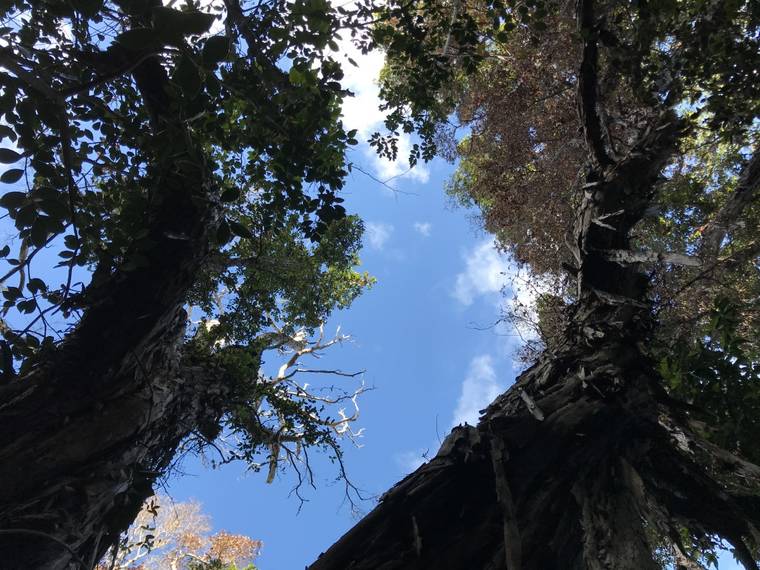Rapid ohia death found on centuries-old tree in Kokee area of Kauai

COURTESY DLNR
Rapid ohia death has been discovered in a centuries-old tree in the Kokee area of northwest Kauai.

COURTESY DLNR
Rapid ohia death has been discovered in a centuries-old tree in the Kokee area of northwest Kauai.


State officials have for the first time found the presence of rapid ohia death in a centuries-old tree in the Kokee area of northwest Kauai.
The tree – along Milolii Ridge Road within Na Pali Kona Forest Reserve — was flagged during helicopter surveys this month. Officials have since confirmed the tree was infected with Ceratocystis lukuohia, the more virulent of the two fungal pathogens that cause the disease.
“The tree was a beauty, hundreds of years old, and bigger around than three people could wrap their arms around,” said Kyle Kagimoto, invasive species technician with Kauai Division of Forestry and Wildlife, in a news release. “Its entire canopy was full of red leaves. That’s what caught our eye during our helicopter surveys.”
Rapid ohia death, a fungal blight that has destroyed hundreds of thousands of native trees in Hawaii, was first detected on Kauai in May 2018.
It had only been known to be present on Hawaii island for many years, but has since been found on Kauai, Maui and Oahu. It has been found in several areas of Kauai.
Two different species of fungal pathogens result in the rapid killing of ohia trees — C. huliohia (disruptor of ohia) and C. lukuohia (destroyer of ohia). Both have been detected on Kauai.
Don't miss out on what's happening!
Stay in touch with breaking news, as it happens, conveniently in your email inbox. It's FREE!
Once afflicted with C. lukuohia, healthy trees appear to die within a few days to a few weeks. Their crowns turn yellow, then brown, as the fungus blocks vascular systems, choking off their water supply.
Officials decided not to fell the tree to protect other plants nearby, but have placed signs near it to alert forest users of the infection.
Although the tree is dead, the fungus can live inside it for years and potentially spread to other ohia, according to Tiffani Keanini, manager of Kauai Invasive Species Committee. People should stay away from the tree, not touch it, sit on it, cut it, or remove any portion of it.
“This detection is significant, because it means the disease is moving into pristine areas of Kauai that are critical to our watersheds and provide habitat for rare plants and animals,” said Sheri S. Mann, Kauai District Manager for DOFAW, in a statement. “Now more than ever, especially as we move into the holiday season when more people may be exploring our forests, we need everyone’s help in following bio-sanitation protocols.”
The pathogens can move through the environment in natural ways, including by wind, and enter the trees through a wound caused by cutting, pruning and root trampling. But they can also be spread by humans via muddy boots and vehicles.
To help prevent the spread of rapid ohia death, experts recommend brushing all soil off of footwear, including slippers, and disinfecting them and any gear with 70% rubbing alcohol. It’s also recommended that forest users wash the mud off vehicles with a high-pressure hose or washer.
If any excursions to Kokee include visiting more than one area or trail, DOFAW recommends decontaminating footwear, gear, and vehicles between each location. Trips that include Milolii Ridge Road should make it the last stop.
Through mid-December, 120 trees have tested positive for C. lukuohia, and 90 for C. huliohia on Kauai. Two tested positive for both pathogens. Another 180 trees were sampled but found to have neither pathogen following molecular testing.
A team of specialists that make up a rapid response team will continue sampling ohia in the Kokee area and around the island.



